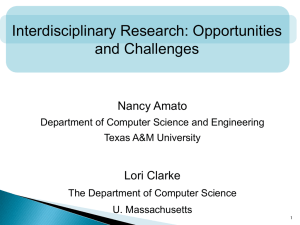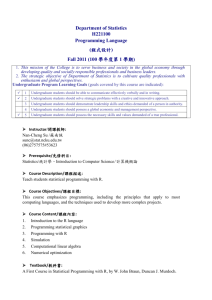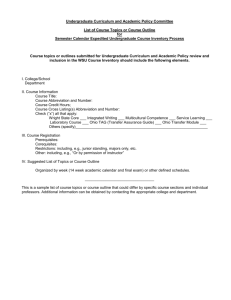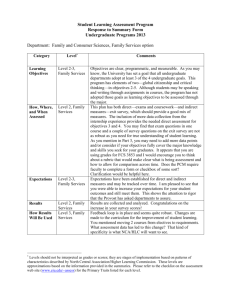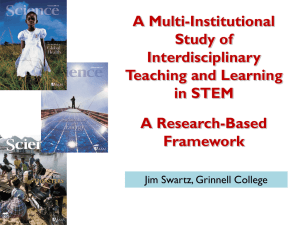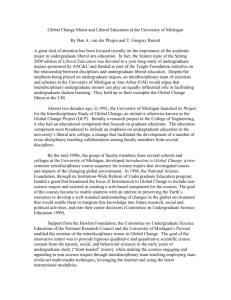Klemow JSE Vol 8 Jan2015 PDF - Journal of Sustainability Education
advertisement
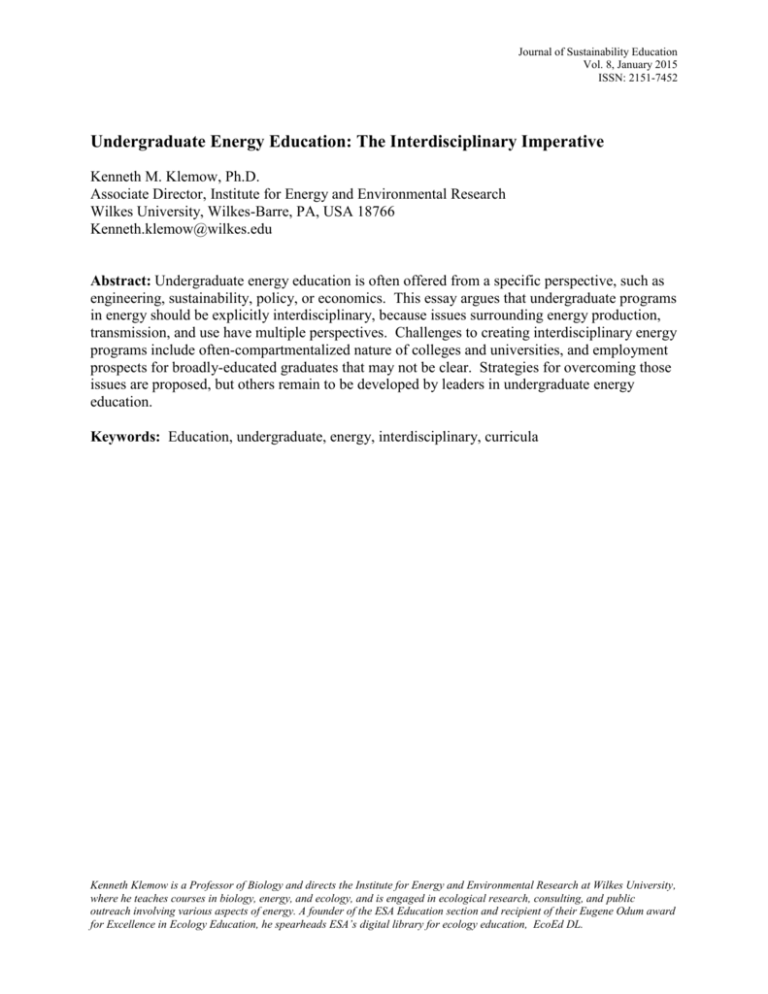
Journal of Sustainability Education Vol. 8, January 2015 ISSN: 2151-7452 Undergraduate Energy Education: The Interdisciplinary Imperative Kenneth M. Klemow, Ph.D. Associate Director, Institute for Energy and Environmental Research Wilkes University, Wilkes-Barre, PA, USA 18766 Kenneth.klemow@wilkes.edu Abstract: Undergraduate energy education is often offered from a specific perspective, such as engineering, sustainability, policy, or economics. This essay argues that undergraduate programs in energy should be explicitly interdisciplinary, because issues surrounding energy production, transmission, and use have multiple perspectives. Challenges to creating interdisciplinary energy programs include often-compartmentalized nature of colleges and universities, and employment prospects for broadly-educated graduates that may not be clear. Strategies for overcoming those issues are proposed, but others remain to be developed by leaders in undergraduate energy education. Keywords: Education, undergraduate, energy, interdisciplinary, curricula Kenneth Klemow is a Professor of Biology and directs the Institute for Energy and Environmental Research at Wilkes University, where he teaches courses in biology, energy, and ecology, and is engaged in ecological research, consulting, and public outreach involving various aspects of energy. A founder of the ESA Education section and recipient of their Eugene Odum award for Excellence in Ecology Education, he spearheads ESA’s digital library for ecology education, EcoEd DL. Undergraduate Energy Education: The Interdisciplinary Imperative The need to know about energy has been part of human existence for millennia. Energy literacy is now essential because we rely so heavily on energy to drive our modern lives, and because many of us recognize that our current dependence on fossil fuels is unsustainable. Regardless, energy has not represented a distinct field of inquiry – as has biology, economics, history, or art. The realization that energy is so important, coupled with widespread perceptions of energy illiteracy, has spurred initiatives to develop courses and even curricula at K-12 and undergraduate levels over the past decade. Examination of college bulletins reveals that programs in undergraduate energy education often arise as offshoots of a particular discipline, such as geology, engineering, or policy. Some colleges treat energy within programs in sustainability – focusing on alternative energy production and reducing consumption. Other colleges, especially those in areas rich in coal, oil, or natural gas, establish programs devoted to one or more fossil fuels. Stories in print, broadcast, or online media consistently remind us that energy relates to multiple disciplines. The connections to STEM (science, technology, and engineering) are obvious, as new innovations for generating and efficiently utilizing energy typically emerge from engineering labs. Assessments of the impacts of individual energy sources to water, air, or ecosystems are the purview of environmental science. The study of fossil fuels is often rooted in petrogeology. But energy is much more than STEM. For example, market forces that help us determine the price of energy clearly have a basis in business or economics. The concepts of Henry Hub prices, trading futures in energy shortages, or the role of energy interconnects are foreign to most people – who even struggle to understand their energy bills. Energy has clear linkages between the social sciences and policy. Much legislation bears upon energy issues (e.g., local and statewide moratoria over fracking, oil drilling in northern Alaska, fuel economy standards), and the policy implications of certain forms of energy development and impacts (e.g., cap and trade for carbon emissions, nuclear power development) are widely debated. Public opinion often influences decisions about placement of energy infrastructure such as high-voltage power lines, compressor stations on gas pipelines, and locating wind turbines. Energy companies spend millions of dollars trying to influence that public opinion through advertising campaigns. Anybody wondering whether energy has any interrelationship to communications and the fine arts need to look no farther than images of flaming faucets portrayed in Gasland, or the catchy animations contained in The Fracking Song available on YouTube. Artists (e.g., http://www.lope.ca/artrenewable/) and authors (e.g. http://www.seamusmcgraw.com/) incorporate energy in their creative work. People accustomed to Daniel Kahneman’s System I thinking style more easily derive meaning from such music, imagery, and narrative than from the graphs and tables that scientists use to deliver their messages. Similarly, philosophers, energy historians, and those intimately familiar with the literature of energy help people understand the issues, think critically about them, and make informed choices. Journal of Sustainability Education http://www.susted.org/ Klemow Energy education must embrace an explicitly interdisciplinary approach if we are to have creative, effective solutions to the challenges before us. Can emerging programs in energy provide the interdisciplinary treatment that the topic deserves? To do so, we must overcome two challenges. First, academic programs are organized into a well-developed disciplinary structure. Universities have academic departments with their often-idiosyncratic cultures and reward systems. Departments are then typically organized into higher-level units, such as schools of engineering, colleges of arts and sciences, or schools of business. Such balkanization of academia makes it difficult to establish interdisciplinary programs that demand to have an academic “home” or reward faculty for teaching – or team-teaching – in disciplines other than those in which they were hired. Solving that problem requires a commitment from faculty across disciplines to work together to develop complementary courses or even team teach, as well as clear support from institutional leaders. Such support can be in the form of reduced loading, enhanced financial rewards to faculty participating in interdisciplinary energy programs (e.g., summer stipends for course development), or strategic hires of faculty with expertise that spans disciplines. Second, employment prospects for students emerging from interdisciplinary programs may not be clear. Admittedly, energy companies often hire individuals with expertise in communications to complement their engineers and environmental experts. Still, many proposed projects that have technical merit fail to come to fruition because of local opposition that could be better anticipated and addressed had they also employed individuals with expertise in social sciences or policy. Similarly, media outlets would benefit by having writers with a solid background in energy issues. To address that issue, program leaders could meet with prospective employers to inquire about their challenges, and ask whether they would be willing to hire program students – or even take them on as interns – to help overcome those challenges. The next decade promises to see a broader creation of energy majors, minors, and certificate programs, especially at the undergraduate level. Developers of such programs should carefully consider the interdisciplinary imperative that energy offers. Embracing connections between STEM disciplines, social sciences, policy, communications, business, and the arts will help create graduates better adapted for addressing multidimensional demands associated with energy production, transmission and consumption. Vol. 8, January 2015 ISSN: 2151-7452


